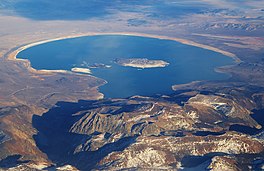
Back بحيرة مونو Arabic Моно (езеро) Bulgarian Llac Mono Catalan Mono Lake CEB Mono (jezero) Czech Моно (кӳлĕ) CV Mono Lake Danish Mono Lake German Lago Mono Esperanto Lago Mono Spanish
| Mono Lake | |
|---|---|
 Aerial photograph of Mono Lake | |
| Location | Mono County, California |
| Coordinates | 38°01′00″N 119°00′34″W / 38.0165908°N 119.0093116°W |
| Type | Endorheic, Monomictic |
| Primary inflows | Rush Creek, Lee Vining Creek, Mill Creek |
| Primary outflows | Evaporation |
| Catchment area | 780 sq mi (2,030 km2) |
| Basin countries | United States |
| Max. length | 13 mi (21 km) |
| Max. width | 9.3 mi (15 km) |
| Surface area | 45,133 acres (18,265 ha)[1] |
| Average depth | 57 ft (17 m)[1] |
| Max. depth | 159 ft (48 m)[1] |
| Water volume | 2,970,000 acre⋅ft (3.66 km3) |
| Surface elevation | 6,383 ft (1,946 m) above sea level |
| Islands | Two major: Negit Island and Paoha Island; numerous minor outcroppings (including tufa rock formations). The lake's water level is notably variable. |
| References | U.S. Geological Survey Geographic Names Information System: Mono Lake |
Mono Lake (/ˈmoʊnoʊ/ MOH-noh) is a saline soda lake in Mono County, California, formed at least 760,000 years ago as a terminal lake in an endorheic basin. The lack of an outlet causes high levels of salts to accumulate in the lake which make its water alkaline.[2]
The desert lake has an unusually productive ecosystem based on brine shrimp, which thrive in its waters, and provides critical habitat for two million annual migratory birds that feed on the shrimp and alkali flies (Ephydra hians).[3][4] Historically, the native Kutzadika'a people ate the alkali flies' pupae, which live in the shallow waters around the edge of the lake.[5]
When the city of Los Angeles diverted water from the freshwater streams flowing into the lake, it lowered the lake level, which imperiled the migratory birds. The Mono Lake Committee formed in response and won a legal battle that forced Los Angeles to partially replenish the lake level.[6]
- ^ a b c "Quick Facts About Mono Lake". Mono Lake Committee. Archived from the original on August 20, 2019. Retrieved January 27, 2011.
- ^ "Water Chemistry". Mono Lake Committee. January 14, 2021. Archived from the original on March 28, 2024. Retrieved May 29, 2023.
- ^ "Birds of the Basin: the Migratory Millions of Mono". Mono Lake Committee. Archived from the original on August 31, 2013. Retrieved December 2, 2010.
- ^ Carle, David (2004). Introduction to Water in California. Berkeley: University of California Press. ISBN 0-520-24086-3.
- ^ "Mono Lake". American Museum of Natural History. Archived from the original on September 22, 2023. Retrieved May 29, 2023.
- ^ Hart, John (1996). Storm Over Mono: The Mono Lake Battle and the California Water Future. University of California Press.
© MMXXIII Rich X Search. We shall prevail. All rights reserved. Rich X Search
